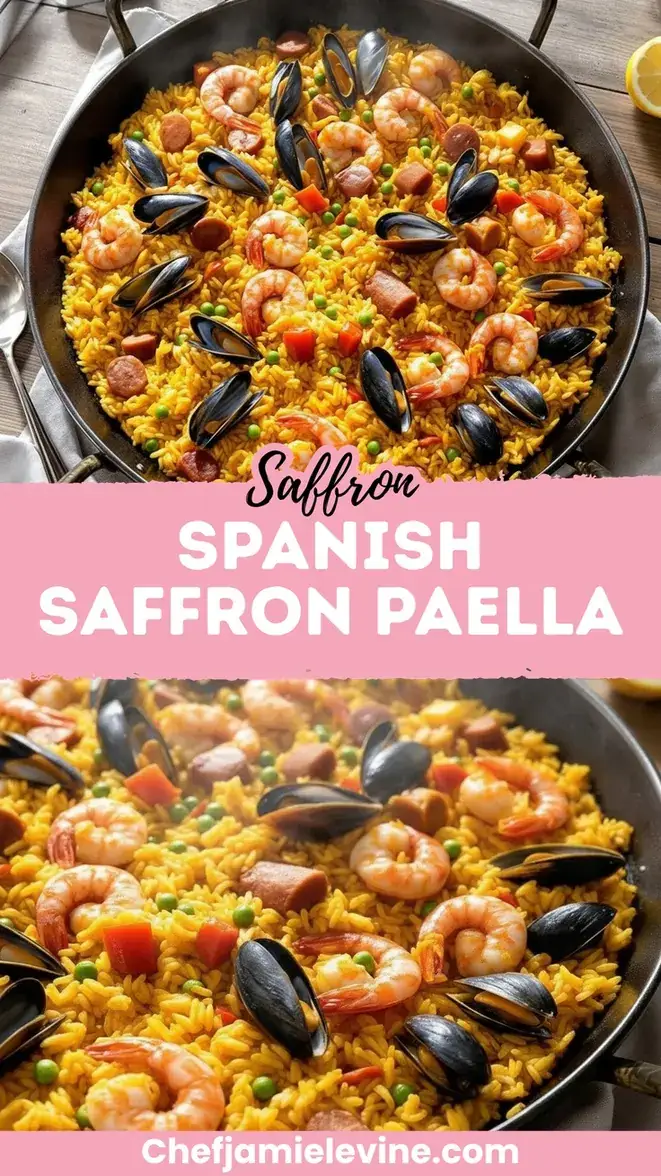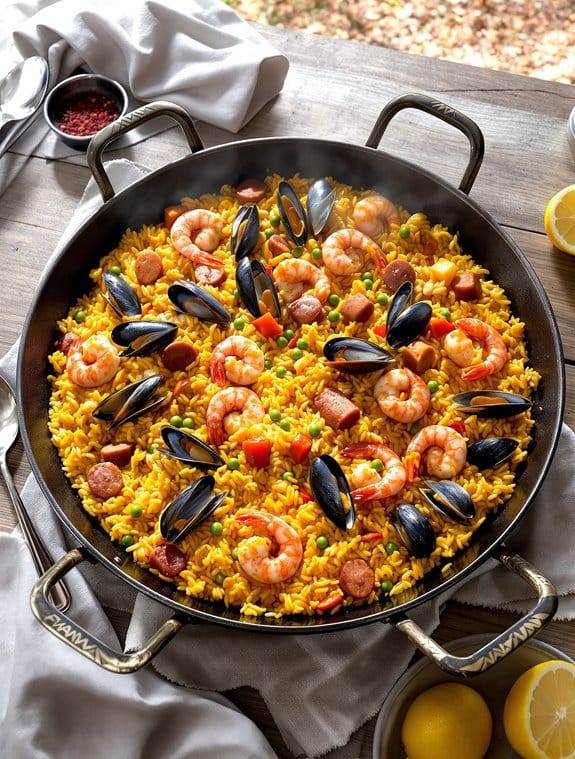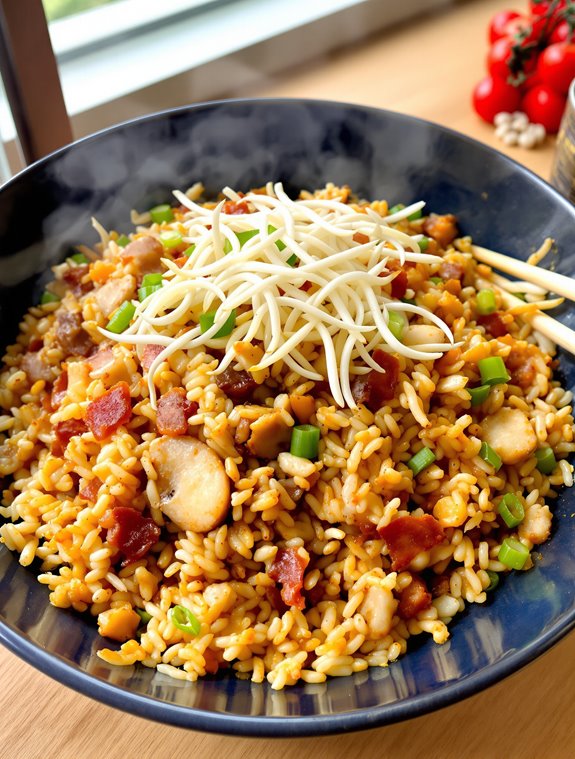Why You’ll Love this Authentic Spanish Paella
If you’re looking for a dish that brings the vibrant flavors of Spain right to your dinner table, this authentic paella recipe is exactly what you need.
I’m obsessed with how the saffron-infused rice creates this gorgeous golden canvas for all the other ingredients.
What makes this recipe special? The combination of savory sausages, tender seafood, and perfectly cooked rice creates layers of flavor in every bite.
The mussels open up to reveal their briny goodness while the shrimp adds a sweet contrast.
And those sweet peas? They add the perfect pop of color and freshness. Pure magic.
What Ingredients are in Authentic Spanish Paella?
The heart of any authentic Spanish paella lies in its carefully selected ingredients that blend together to create a symphony of flavors. This traditional dish combines the earthiness of rice and spices with the richness of meats and seafood, all brought together in one spectacular pot.
I’m always amazed at how such simple ingredients can transform into something so incredibly special when combined with care and attention.
- 1 cup Vidalia onion, small dice
- 5 garlic cloves, minced
- 1 whole red bell pepper, diced
- 1 tablespoon olive oil
- 2 teaspoons Spanish paprika
- 1/2 lb kielbasa, sliced on the diagonal
- 1/2 lb andouille sausage, sliced
- 1 1/2 cups uncooked white rice (Basmati works well)
- 2 2/3 cups good chicken stock, plus extra as needed
- 1 pinch saffron threads
- 1 lb fresh mussels
- 1 lb medium raw shrimp, peeled & deveined
- 1 cup frozen sweet peas
- 2 tablespoons fresh parsley, chopped
While traditional Spanish paella often uses different regional sausages, this recipe adapts with more widely available kielbasa and andouille, which still provide that wonderful smoky flavor.
The saffron is non-negotiable, though—it’s what gives paella its distinctive golden color and unique flavor profile. You might be tempted to skip it because of the price, but even that tiny pinch makes all the difference between a good rice dish and an authentic paella experience.
And don’t worry about exact measurements for the extra chicken stock; you’ll just want to have some on hand to adjust as you cook.
How to Make this Authentic Spanish Paella

Making paella is all about layering flavors, and while you could use just one large pot for the entire process, I find that sometimes using a few pans helps me control each element perfectly.
Start by sautéing 1 cup of diced Vidalia onion, 5 minced garlic cloves, and 1 diced red bell pepper with 2 teaspoons of Spanish paprika in 1 tablespoon of olive oil. This aromatic base is what gives the paella its foundation of flavor.
In the same pan (or another if you prefer), brown both the 1/2 pound of sliced kielbasa and 1/2 pound of andouille sausage. These sausages don’t release much fat, which makes them perfect for this dish—you get all the flavor without the greasiness.
Next comes the essential rice-cooking step. Bring 2 2/3 cups of chicken stock to a boil with a pinch of saffron threads—that gorgeous golden spice that’s worth every penny. Add 1 1/2 cups of uncooked white rice (Basmati works beautifully here), cover, and simmer for about 15 minutes. Don’t worry if the rice isn’t completely done at this point; it’ll continue cooking when you add the seafood.
Speaking of which, the 1 pound of fresh mussels goes in first—just nestle them into the rice, add more stock if needed, and cover until they open, which takes about 20 minutes.
Then add 1 pound of peeled and deveined shrimp, which need only about 5 minutes to cook through.
Finish with 1 cup of frozen sweet peas and 2 tablespoons of freshly chopped parsley, giving everything a gentle stir to incorporate. Isn’t it amazing how all these different elements come together in one magnificent dish?
Authentic Spanish Paella Substitutions and Variations
While creating this iconic Spanish dish allows for personal expression, authentic paella can actually embrace several regional variations and substitutions without losing its soul.
If you can’t find saffron (though it’s worth the splurge), turmeric offers color but a different flavor profile. No access to traditional Spanish rice? Basmati works in a pinch, as I’ve discovered on desperate weeknight cooking adventures.
The protein lineup is wonderfully flexible too. Swap kielbasa for chorizo, use chicken instead of seafood, or go full vegetarian with extra bell peppers and artichokes.
Valencia natives might raise an eyebrow, but hey—paella’s true spirit lives in technique, not rigid ingredient lists.
What to Serve with Authentic Spanish Paella
Since authentic paella serves as the star of your meal, I’ve found that simple, fresh accompaniments work best to complement rather than compete with its rich flavors.
A crisp green salad with a light vinaigrette adds brightness, while warm crusty bread is perfect for soaking up those saffron-infused juices.
I love serving a chilled Spanish albariño or sangria alongside—nothing beats that combination on a warm evening.
Unlike the recipe above suggesting cornbread (which isn’t traditional), I prefer pan con tomate or marinated olives as authentic Spanish starters.
Final Thoughts
Authenticity lies at the heart of truly magnificent paella.
While my recipe incorporates some non-traditional elements like kielbasa and andouille sausage, the technique and essence remain true to Spanish tradition.
I’ve found that cooking paella is as much about patience as it’s about ingredients—letting those saffron threads work their magic, waiting for mussels to reveal themselves, watching rice absorb rich stock.

Authentic Spanish Paella With Saffron
Ingredients
Equipment
Method
- Heat olive oil in a large pan. Add diced Vidalia onion, minced garlic cloves, and diced red bell pepper. Sauté until softened, then stir in Spanish paprika.
- In the same pan (or another if preferred), brown the sliced kielbasa and andouille sausage until lightly caramelized.
- Bring chicken stock to a boil in a large paella pan or skillet. Add saffron threads and stir to infuse the liquid.
- Add the uncooked rice to the saffron-infused stock, cover, and simmer for about 15 minutes until rice is partially cooked.
- Nestle the fresh mussels into the rice. Add more stock if needed to keep the mixture moist. Cover and cook for about 20 minutes until the mussels begin to open.
- Add the peeled and deveined shrimp to the pan, gently pushing them into the rice. Cook for approximately 5 minutes until the shrimp turn pink and are cooked through.
- Stir in the frozen sweet peas and freshly chopped parsley. Give everything a gentle stir to incorporate all ingredients while maintaining the presentation.



